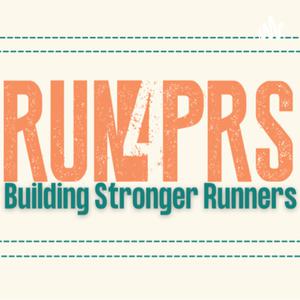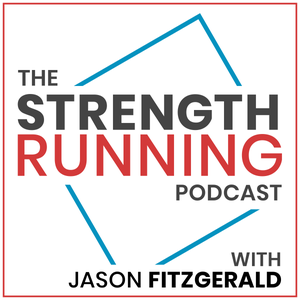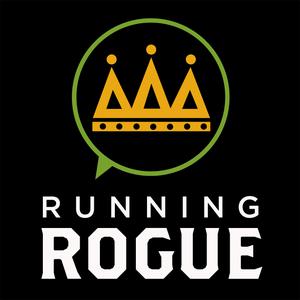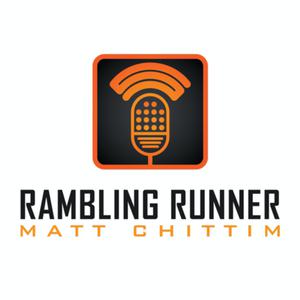
Run4PRs
Run4PRs
We build stronger runners at Run4PRs Coaching. This podcast is filled with training tips & personal stories from the @run4prs coaches like 13x Boston Qualifier Victoria Phillippi. Our goal is to empower you with training tips & help you become the best athlete you can be. Want to get a more customized approach or consult with us directly on YOUR running questions? —-> www.Run4prs.com for a free 7 day trial
- 42 minutes 39 seconds241. Strengths and weaknesses as a runner
Assessing your strengths and weaknesses is key for building self awareness and also knowing what you should work on! When we know where we could use a little work, we can channel our energy to that area of life. This is important for your personal life as well as for your running. You will be able to better reach your potential when you know what direction to go. We have 3 areas of runner traits we are going to address in this episode as well as ways to turn your weaknesses into your strengths. For more information on this we have a commit60 mental training toolkit on our website that goes into this in depth.
Weaknesses
1- impatient- you want results right away, you speed up at the end of runs
Forced into a waiting pattern with winter, illness, pregnancy, etc.
Some people say they can’t slow down on their easy days:
Make yourself wait
Meditation/mindfulness
Deep breathing
Yoga
Read
Do a puzzle
Accept what you cannot change & practice empathy
2- Too negative/self critical- you beat yourself up, perfectionist tendencies, unable to see positives, can lead to black or white thinking
Mindfulness
Recognize your triggers
Come up with neutral statements instead
Try a gratitude journal
3- inconsistent- lacking organization or discipline
Routine
Run streak
Accountability buddy
Building a habit/habit stacking
4-insecurity- doesn’t believe in themselves, races workouts, pushing it on easy days
Practice self care: nutrition, sleep, boundaries
Maybe you always wanted a coach or to buy a certain pair of shoes: do it!
Step away from toxic people, spend time with people who make you feel good
Write down a list of things you are good at
5- Lack of experience- pacing, grows with time, technical
Get experience
Sign up for races
Hire a coach
Try new workouts
6-over analyzing- focusing too much on the details
What do you over analyze?
Weekly mileage (run 49.5 miles one week)
Paces (don’t hit your paces)
Run streaks (break it)
Certain workouts (eliminate something you think is super important- IE yassos 800)
How many 20 milers (run 18-19 milers)
Focus on trusting the big picture
26 April 2024, 6:42 pm - 45 minutes 12 seconds240. Marathon in 99% aerobic
Most runners know that we want to build our aerobic system while running. The marathon and half marathon are said to be 99% AEROBIC in nature. It only makes sense that distance runners should focus on that aerobic development the most. However, when it comes to the shorter distance races like the 1 mile or 5k, more of our performance is going to require development of the anaerobic system. We want to chat today about the different systems used and the type of workouts you should focus on for each type of distance you are training for.
What is the anaerobic system?
How long can you run at an anaerobic pace?
What is the aerobic system?
How long can you run at an aerobic pace?
The marathon & half marathon are 99% aerobic in nature: TEMPO, progression, LT, MP, steady state
What kind of workouts will help build the aerobic systems?
What kind of workouts should you avoid during marathon training?
If you did only speed work during a marathon training cycle, could you still run fast in the marathon- why/why not?
Training specifically for the distance matters
The 5k is 90% aerobic. I said earlier it is important to develop the anaerobic 10% because that is a 1-2 min of the race.
How would you train 5k runners?
What type of speed workouts?
How often do you do a speed workout vs threshold?
How long of a long run?
The 1 mile is like 60% aerobic. A lot more of this race is anaerobic. How do we develop runners for this?
What type of workouts do you run?
Would running long make you slower?
Why do college xc coaches not allow their runners to do a marathon?
What are running workouts?
Track workouts
What is an easy run? Why do we do easy runs most of the time?
We need to go slower to build the aerobic base
You need to go slow enough to recover from workout days
“I can’t slow down. My legs won’t let me”
Your workouts aren’t hard enough
You aren’t running enough
“9 mile marathon plan”
Mileage is key to success: You can get away with less mileage if you have a strong aerobic base like a masters runner or a triathlete
What are the best time of running workouts to do?
Training for a 5k 10% anaerobic
Speed work comes into play
Training for a 10k
Training for a half 99% aerobic
Training for a full
Video on youtube that goes over all of this
Medium long runs
Steady State Runs
Threshold workouts
Long runs in the mid-zone not hyper focused on the 20
Training for an ultra
What are the most common mistakes we see athletes make
Running in the gray zone
Not doing the correct workouts
Only doing workouts they are comfortable with
Not progressing stress
Doing too much too soonMara
19 April 2024, 5:15 am - 51 minutes 26 seconds239. Ask The Coaches Podcast: "Are You Fast Enough To Wear Supershoes like Alphaflys?"
I can't complete 20 miles in 3 hours, can I do 5 easy + 10 mp + 5 easy?239
3 hour long run rule
Marathon pace work- when is it good
Can I run a marathon 6 weeks after running a marathon?
Marathon manics
Ultra marathons
Racing vs running
50 states
What should be the fartlek pace?
Fartlek = speed play
How to get constant speed for a longer run
How are we measuring this?
Do we need to go fast on long runs?
Is HR too high 170-180 for MP?
Easy Pace only improved by 30-60 sec after a year of zone 2… is this normal?
What is the best shoe for a first time marathon?
4 April 2024, 7:01 pm - 52 minutes 20 seconds238. How to Figure Out Goal Race Pace
We sometimes see runners on strava or IG referencing their ‘goal race pace’ for various distances. We wanted to do a deep dive into how useful this actually is to train using goal race paces or if it is actually detrimental to your progress as a runner. Should you be training using your goal race paces or should you be training at your current fitness level?
What causes someone to want to train at goal race pace
We want to run a sub 3:00 marathon and know that is a 6:52 pace. We think that if we train & do workouts with 6:52 pace as marathon pace, we will be in sub 3 hour marathon shape
The FLAW with this logic: You could be racing workouts.
Many marathon workouts are broken up with rest intervals. Let’s give for example a workout like 3 x 2 miles at marathon pace within a long run. Someone who is in 3:10 marathon shape could do a 3x 2 mile workout at 6:50 pace. However, this 6:50 pace is their threshold pace.
Another common example- women in 3:45 shape and wants to BQ
When she trains with an 8:00 marathon pace: this is actually her threshold pace. When she does a threshold workout at 7:30 pace, she is actually dipping into interval pace and anaerobic territory. Physically she can do these workouts, but they will be too stressful over time and lead her into worse shape and not improving
Not only will she be working very hard and not improving, she will be frustrated on race day because her training workouts indicated that she was in better shape than she actually was. Little does she know, she was racing most of her workouts and overtraining during her training cycle
When we don’t train at the correct paces, we neglect the purpose of the workout & negate a lot of the benefits
It is not good to set a goal and train at “GOAL” paces. Instead, you should train at the fitness you are currently at which will allow you to progress and reap the benefits of the workouts
How should you figure out what pace to run
Do a race or time trial
If the 3:45 chick raced a 5k in 23:00 and we discovered her marathon pace is 8:22 and threshold pace is 7:50, we can use these paces in training
We would retest fitness in 4-6 weeks. It is better to slightly undershoot workouts than overshoot them.
Even if you think you are in better shape, you need to be honest and do a race. It doesn’t benefit you to run faster than you should.
What if you really want to run a BQ time but the fitness just isn’t there?
Have it be a longer term goal and focus on other benchmarks to get theseHow o
29 March 2024, 10:47 am - 41 minutes 35 seconds237. Adding in hills
Many runners dislike hills for a number of reasons. They are hard & they can slow you down! Many people avoid hills because they don’t like how hilly routes slow down their average pace. It is important to work on things we are not good at in order to improve as athletes. When we neglect our weaknesses, we do not improve as much as we could have! Hills not only will help you on hiller races, but they also improve your running in other ways. They increase your power, help with form & allow you to build stronger legs. When you work on hills, you can become a more well-rounded runner AND run faster on flat ground as well. Today we will be talking about different type of hill workouts and how to add them into training
We get used to doing the hills. At first it feels really hard. If you are used to it, it’s not a big deal.
Training for hilly races vs flat races
If you are training for a hilly race, hill work is a must
Even downhill races need downhill work
Simulation of the race
Boston marathon is very hilly and doing a lot of miles on rolling hills helps
Regular training adding in hill work even when training for a flat race
Hill repeats helping with vo2max & power
Tempos
Steady state on rolling hills- effort based. Some people are better at downhills vs uphills. You're not going to be able to get a pace band that tells you exactly what pace you should be at each second.
Mile repeats on rolling hills
Long run steady on hills
Easy runs on hills
Speed work
VO2max type workouts on hills
Combo/mixed workout
Hill sprints then tempo work after
22 March 2024, 4:47 pm - 41 minutes 14 seconds236. Become a Better Racer: Hit Your Goals On Race Day!
Have you ever seen an athlete have an amazing race and wonder how they were able to pull it off? Do you ever wish you could get the extra edge that other athletes seem to have on race day? Today we are going to be talking about the main factors that go into having a great race. There are a variety of areas you can improve on when it comes to mastering your race day performance. When you try to get 1% better in each area, it adds up to be a lot!
Training For The Event/Distance with specific workouts
Anaerobic
Aerobic
Workouts 20% of the time
Paces specific to your VDOT fitness
Being selective with your races
You can’t expect to race every month and improve forever
You need time to train for the races
Picking courses that are FAST
Picking races during optimal time of year
Course spectators? People to run with?
Limiting how often you race
Building the mental muscle
Doing uncomfortable things
Sarah Sellers 2018 Boston Marathon: she ran after working nursing shirts. When you train in a tired state, it can help with the rough patches during a race
You don’t need to train in perfect conditions or always feel like running
Building confidence in workouts by practicing negative splits
Don’t let yourself get handicapped by yourself: “I always blow up”, “I am not good at marathons”. You have to practice how you speak to yourself and not go down a negative spital
The little things like tapering, fueling and carb loading
Carbon plated shoes can make you faster
Beats can make you faster
Fueling properly will allow you to race to your potential in events over 90 min
Hydration is key
Make sure you have all the loose ends taken care of!
14 March 2024, 5:00 am - 38 minutes 4 seconds235. Train at 80% and race at 100%
Lots of runners love the feeling of crushing a big workout and having something they can confidently hang their hat on as a statement of their race day abilities in training. However, when athletes constantly overreach and dig too far into the well for workout days, are they testing their fitness or is it training? Are there potential drawbacks to leaving it all out there during every single workouts?
What is the potential problem with going too fast on workout days
Tempo runs turn into vo2max when defeats the purpose
Almost better to go slower
Might be disappointed when you don’t have another gear on race day
Your PR might be in a workout
Not as efficient with energy
Going to 100% takes longer to recover from and it’s harder on body
Hard to trust the process
7 March 2024, 11:46 am - 38 minutes 33 seconds234. How to make time for training
Finding time to get in the miles can be challenging. We all live busy lives! However, most athletes who have been in the sport of running for a long time will attest to making training a part of your routine is a key to success. If we don’t make the time for running, we typically run out of time at the end of the day.
Running in the morning
How early do you need to wake up
Fueling before a run
Running slower in the morning
Eating after= you will be hungry during work
Running over lunch
Good if you work from home
Stroller/SAHM life
Coworkers might think you are weird
Eating lunch at desk after
Running in the afternoon
Hard if you come home first
Pack clothes and run immediately after from work or drive to destination
Hard if people want you to do Happy Hours
Hard if you are a parent of young kids
Might work if you can run during your kids sports practices in the evening if they are older
Utilizing treadmill/gym/stroller running
Good option for the weekend
Days you can be more flexible and/or something co
26 February 2024, 11:37 am - 35 minutes 16 seconds233. Does Slowing Down On Easy Days Actually Work?
Running is an aerobic sport! We need to train in the aerobic zones to improve at long distance running. The biggest mistakes runners make is going too fast on your easy days. Going too fast on your easy days puts you at risk of burn out and injury. It also prevents you from reaching your potential in the sport. Many people refuse to slow down and never are able to increase their mileage or long run duration because the speed they are running at is too fast to make additional stress adaptations like improving endurance and ability to run on fatigued legs.
Many people slow down on easy days compared to race day but they do not slow down ENOUGH to fully recover. Athletes often have a skewed perception on what ‘easy’ running means. Yes, running 1 min per mile slower than 5k pace is easier than racing a 5k, but is it slow enough to improve?
Social media. A lot of the big influencers are BQ athletes. They are showing their easy paces that are in the 8-9 min pace range. For them it could be easy but we want to make sure we don’t compare ourselves to others.
I have friends who refuse to run slower than XYZ pace might be a challenge if you have a partner who is constantly pushing the pace. We might need to make changes to who we run with if it’s holding us back from reaching our goals.
Easy running allows you to improve your aerobic base
Working the correct zones
Pacing: who is really in control
When you are mid-race you want to listen to your body and not what the watch says
The more practice you have listening to your body the more confident you can become
Easy running allows you to increase mileage
More miles = more aerobic development
Running easy allows you to recover between workout days
Workouts are important for lowering speed and threshold
15 February 2024, 11:35 am - 41 minutes 51 seconds232. What Workouts To Get Faster: Examples & How To Calculate Them
Workouts are a very important part of reaching your potential as a runner. We talk a lot about the benefits of easy running but sometimes we neglect to talk about the importance of not only running hard workouts but the importance of WHAT workouts you do. If you are training for a marathon, you don’t want to be spending a ton of time doing sprinting anaerobic workouts. Training the right systems for your goals is important. It is equally as important to make sure you are training at the appropriate paces for your current fitness levels so that you are stressing the correct systems to improve!
How much mileage per week should be running workouts
10-20% (for 40 miles a week that is 4-8 miles per week)
Workout days should always have warm up and cool down miles
4-8 miles of hard work can be split up into 2 runs with 2-2 mile warm up at cool downs
Your workout days may be 8 miles in total but only contain 3-4 miles of hard running in them
How do you know what paces you should be running
Test fitness with a 5k
VDOT calculator
Make adjustments based on training conditions/wind/heat/hills/etc!
Effort based can work but we don’t want to go 100% based off that in the beginning when we are learning
What type of workouts are best for the marathon/half marathon
Longer tempos
Steady states
MP tempos as race approaches
Threshold work
Medium long run
Cut down/progression runs
What type of workouts are best for the 5k/10k
Threshold workouts
Speed workouts
6 February 2024, 11:34 am - 36 minutes 39 seconds231. How To Build Mileage
How many miles do you run per week? How does one build up to be able to run 50 or even 100 mile weeks? Should everyone try to achieve high mileage? These are all great questions we will be addressing in this episode. Usually, runners will see great gains in fitness in the beginning of their running journey from simply going from running 0 miles to 10 miles per week. In the beginning it almost seems like the more we run, the better we get. However, there becomes a point when it becomes counter productive.
How do you know if it’s time to start increasing mileage
Are you improving
We want to assess if you are training at the appropriate paces for easy days
You are not always injury prone and needing to run low mileage: sometimes there is a different variable at play
What is your history: masters runner, new runner, injury prone
How do you feel?
Do you have time?
Does more mileage equal better results
You can only run as much as you can recover from
Running more only is helpful to a point
Counter productive: injury/burnout
How do you increase?
10% per week max
Cut back weeks every 1-3 weeks of 75% volume
How often should you assess mileage
Every week/every season/every year
Your body and goals change
You should not always be running peak mileage
25 January 2024, 11:33 am - More Episodes? Get the App
Your feedback is valuable to us. Should you encounter any bugs, glitches, lack of functionality or other problems, please email us on [email protected] or join Moon.FM Telegram Group where you can talk directly to the dev team who are happy to answer any queries.
 I'll Have Another with Lindsey Hein Podcast
I'll Have Another with Lindsey Hein Podcast
 The Strength Running Podcast
The Strength Running Podcast
 Running Rogue
Running Rogue
 The Rambling Runner Podcast
The Rambling Runner Podcast
 The Running Explained Podcast
The Running Explained Podcast
 Run to the Top Podcast | The Ultimate Guide to Running
Run to the Top Podcast | The Ultimate Guide to Running